Nursing: Scholarship Journey, Professional Development, and Education
VerifiedAdded on 2023/04/22
|17
|4992
|393
Report
AI Summary
This report explores the multifaceted dimensions of nursing scholarship and professional development, emphasizing their crucial role in advancing nursing practice and education. The report begins by defining nursing scholarship within the context of financial aid and the criteria for its award, differentiating between merit-based, need-based, and career-specific scholarships. It highlights the importance of scholarship activities for Advanced Practice Nurses (APNs) and the four dimensions of nursing scholarship, including the scholarship of discovery, teaching, application, and integration, based on Boyer's seminal work. The report then delves into the professional development of nurses, emphasizing the dynamic healthcare environment and the need for continuous education and mentoring. It discusses the role of Nursing Professional Development (NPD) specialists in guiding nurses through career advancement, certification, and licensing requirements. The report also provides insights into program and curriculum design, assessment, and evaluation within nursing education, including course development, goals, objectives, and learning outcomes. The report also considers the interprofessional collaboration (IPC) and interprofessional education (IPE) in nursing curricula, emphasizing the importance of teamwork and communication for optimal patient outcomes.
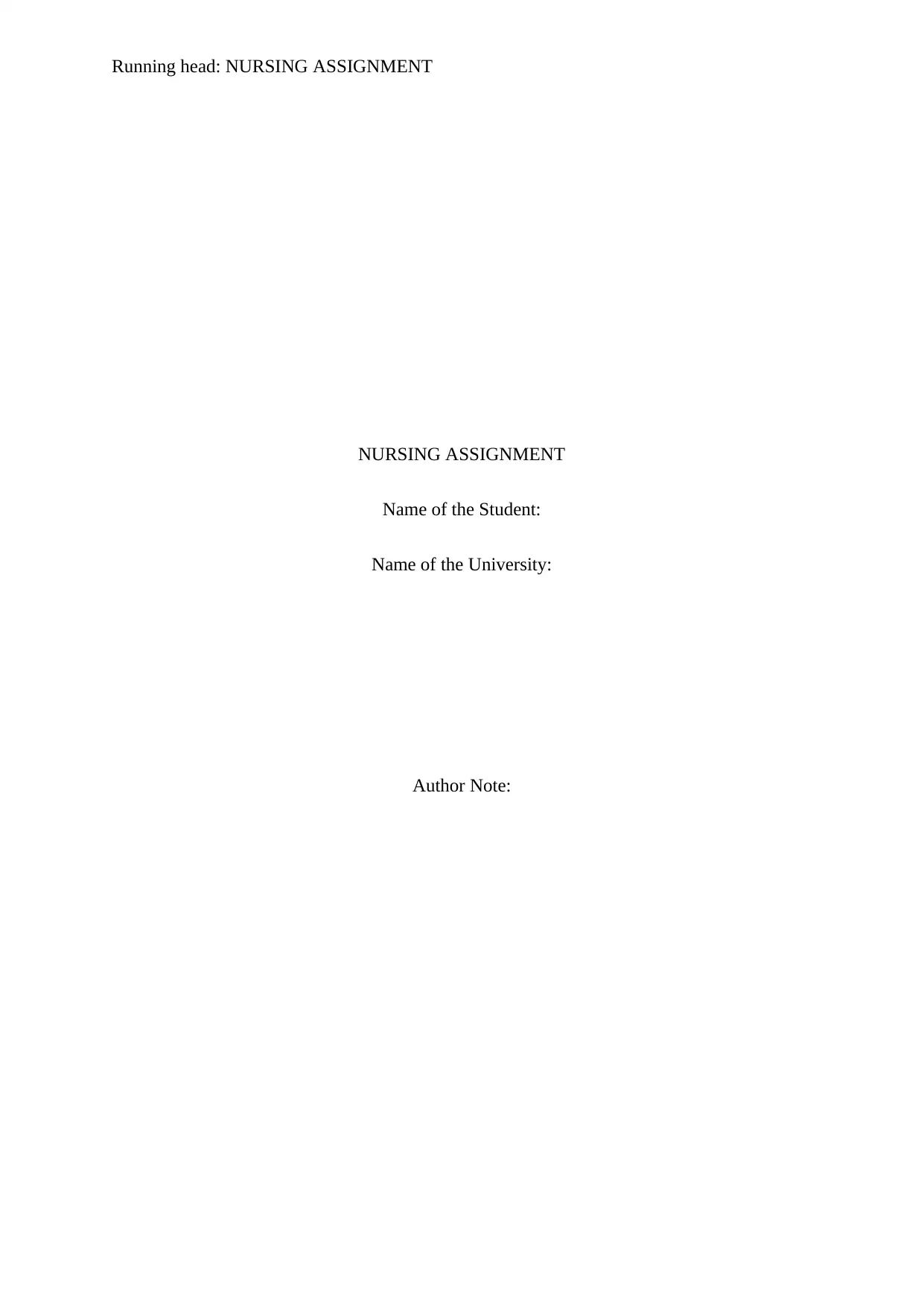
Running head: NURSING ASSIGNMENT
NURSING ASSIGNMENT
Name of the Student:
Name of the University:
Author Note:
NURSING ASSIGNMENT
Name of the Student:
Name of the University:
Author Note:
Paraphrase This Document
Need a fresh take? Get an instant paraphrase of this document with our AI Paraphraser
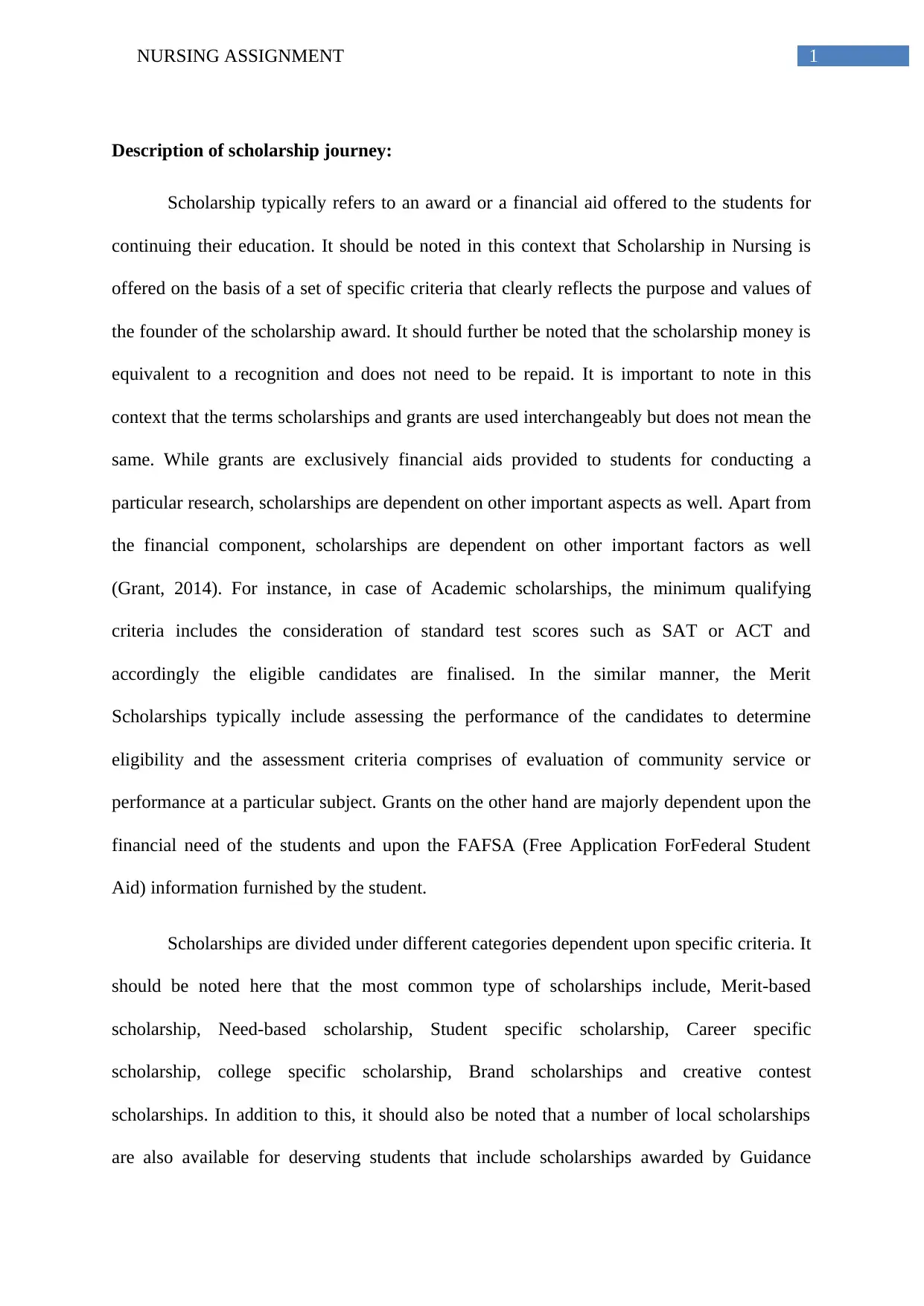
1NURSING ASSIGNMENT
Description of scholarship journey:
Scholarship typically refers to an award or a financial aid offered to the students for
continuing their education. It should be noted in this context that Scholarship in Nursing is
offered on the basis of a set of specific criteria that clearly reflects the purpose and values of
the founder of the scholarship award. It should further be noted that the scholarship money is
equivalent to a recognition and does not need to be repaid. It is important to note in this
context that the terms scholarships and grants are used interchangeably but does not mean the
same. While grants are exclusively financial aids provided to students for conducting a
particular research, scholarships are dependent on other important aspects as well. Apart from
the financial component, scholarships are dependent on other important factors as well
(Grant, 2014). For instance, in case of Academic scholarships, the minimum qualifying
criteria includes the consideration of standard test scores such as SAT or ACT and
accordingly the eligible candidates are finalised. In the similar manner, the Merit
Scholarships typically include assessing the performance of the candidates to determine
eligibility and the assessment criteria comprises of evaluation of community service or
performance at a particular subject. Grants on the other hand are majorly dependent upon the
financial need of the students and upon the FAFSA (Free Application ForFederal Student
Aid) information furnished by the student.
Scholarships are divided under different categories dependent upon specific criteria. It
should be noted here that the most common type of scholarships include, Merit-based
scholarship, Need-based scholarship, Student specific scholarship, Career specific
scholarship, college specific scholarship, Brand scholarships and creative contest
scholarships. In addition to this, it should also be noted that a number of local scholarships
are also available for deserving students that include scholarships awarded by Guidance
Description of scholarship journey:
Scholarship typically refers to an award or a financial aid offered to the students for
continuing their education. It should be noted in this context that Scholarship in Nursing is
offered on the basis of a set of specific criteria that clearly reflects the purpose and values of
the founder of the scholarship award. It should further be noted that the scholarship money is
equivalent to a recognition and does not need to be repaid. It is important to note in this
context that the terms scholarships and grants are used interchangeably but does not mean the
same. While grants are exclusively financial aids provided to students for conducting a
particular research, scholarships are dependent on other important aspects as well. Apart from
the financial component, scholarships are dependent on other important factors as well
(Grant, 2014). For instance, in case of Academic scholarships, the minimum qualifying
criteria includes the consideration of standard test scores such as SAT or ACT and
accordingly the eligible candidates are finalised. In the similar manner, the Merit
Scholarships typically include assessing the performance of the candidates to determine
eligibility and the assessment criteria comprises of evaluation of community service or
performance at a particular subject. Grants on the other hand are majorly dependent upon the
financial need of the students and upon the FAFSA (Free Application ForFederal Student
Aid) information furnished by the student.
Scholarships are divided under different categories dependent upon specific criteria. It
should be noted here that the most common type of scholarships include, Merit-based
scholarship, Need-based scholarship, Student specific scholarship, Career specific
scholarship, college specific scholarship, Brand scholarships and creative contest
scholarships. In addition to this, it should also be noted that a number of local scholarships
are also available for deserving students that include scholarships awarded by Guidance
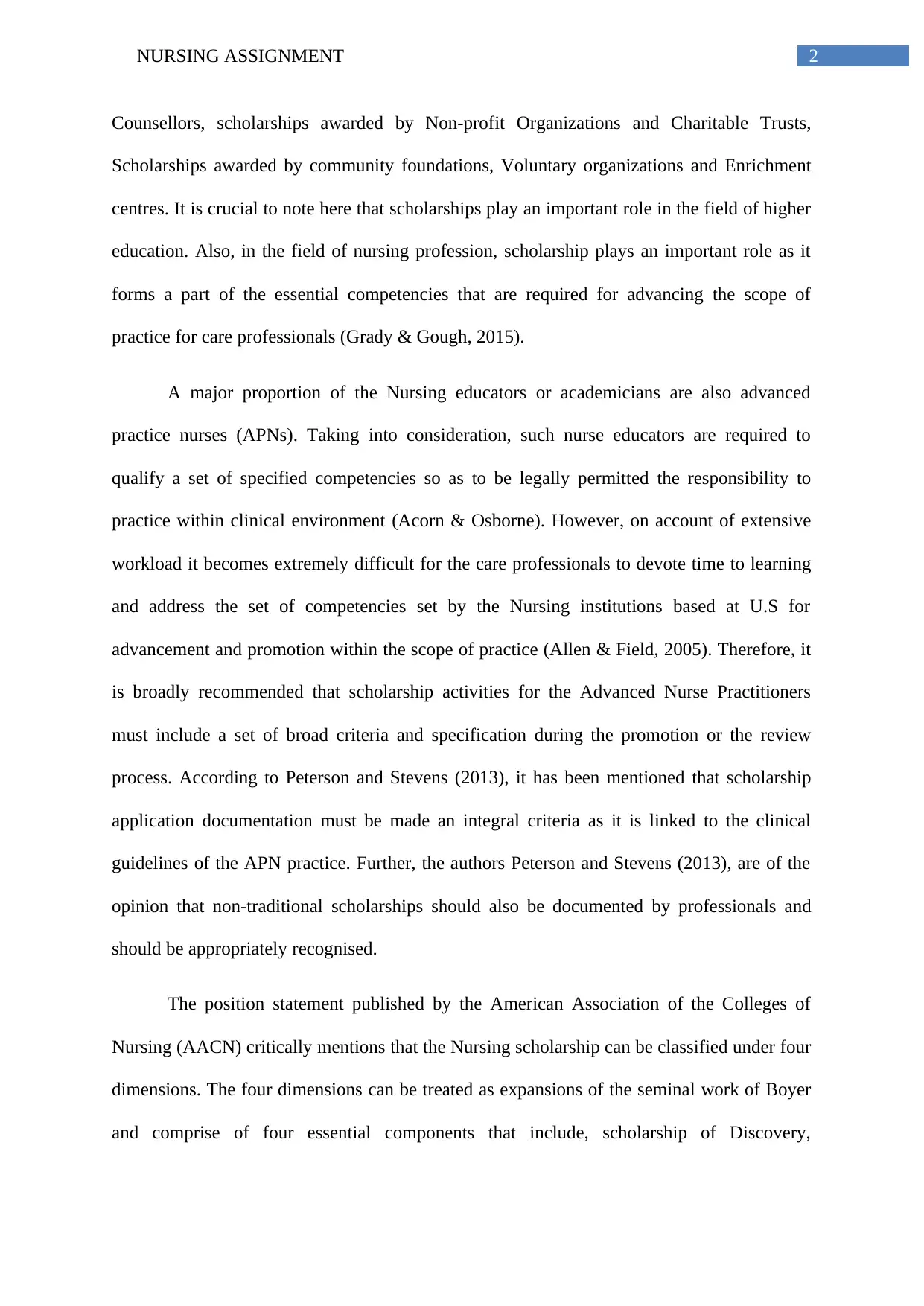
2NURSING ASSIGNMENT
Counsellors, scholarships awarded by Non-profit Organizations and Charitable Trusts,
Scholarships awarded by community foundations, Voluntary organizations and Enrichment
centres. It is crucial to note here that scholarships play an important role in the field of higher
education. Also, in the field of nursing profession, scholarship plays an important role as it
forms a part of the essential competencies that are required for advancing the scope of
practice for care professionals (Grady & Gough, 2015).
A major proportion of the Nursing educators or academicians are also advanced
practice nurses (APNs). Taking into consideration, such nurse educators are required to
qualify a set of specified competencies so as to be legally permitted the responsibility to
practice within clinical environment (Acorn & Osborne). However, on account of extensive
workload it becomes extremely difficult for the care professionals to devote time to learning
and address the set of competencies set by the Nursing institutions based at U.S for
advancement and promotion within the scope of practice (Allen & Field, 2005). Therefore, it
is broadly recommended that scholarship activities for the Advanced Nurse Practitioners
must include a set of broad criteria and specification during the promotion or the review
process. According to Peterson and Stevens (2013), it has been mentioned that scholarship
application documentation must be made an integral criteria as it is linked to the clinical
guidelines of the APN practice. Further, the authors Peterson and Stevens (2013), are of the
opinion that non-traditional scholarships should also be documented by professionals and
should be appropriately recognised.
The position statement published by the American Association of the Colleges of
Nursing (AACN) critically mentions that the Nursing scholarship can be classified under four
dimensions. The four dimensions can be treated as expansions of the seminal work of Boyer
and comprise of four essential components that include, scholarship of Discovery,
Counsellors, scholarships awarded by Non-profit Organizations and Charitable Trusts,
Scholarships awarded by community foundations, Voluntary organizations and Enrichment
centres. It is crucial to note here that scholarships play an important role in the field of higher
education. Also, in the field of nursing profession, scholarship plays an important role as it
forms a part of the essential competencies that are required for advancing the scope of
practice for care professionals (Grady & Gough, 2015).
A major proportion of the Nursing educators or academicians are also advanced
practice nurses (APNs). Taking into consideration, such nurse educators are required to
qualify a set of specified competencies so as to be legally permitted the responsibility to
practice within clinical environment (Acorn & Osborne). However, on account of extensive
workload it becomes extremely difficult for the care professionals to devote time to learning
and address the set of competencies set by the Nursing institutions based at U.S for
advancement and promotion within the scope of practice (Allen & Field, 2005). Therefore, it
is broadly recommended that scholarship activities for the Advanced Nurse Practitioners
must include a set of broad criteria and specification during the promotion or the review
process. According to Peterson and Stevens (2013), it has been mentioned that scholarship
application documentation must be made an integral criteria as it is linked to the clinical
guidelines of the APN practice. Further, the authors Peterson and Stevens (2013), are of the
opinion that non-traditional scholarships should also be documented by professionals and
should be appropriately recognised.
The position statement published by the American Association of the Colleges of
Nursing (AACN) critically mentions that the Nursing scholarship can be classified under four
dimensions. The four dimensions can be treated as expansions of the seminal work of Boyer
and comprise of four essential components that include, scholarship of Discovery,
⊘ This is a preview!⊘
Do you want full access?
Subscribe today to unlock all pages.

Trusted by 1+ million students worldwide
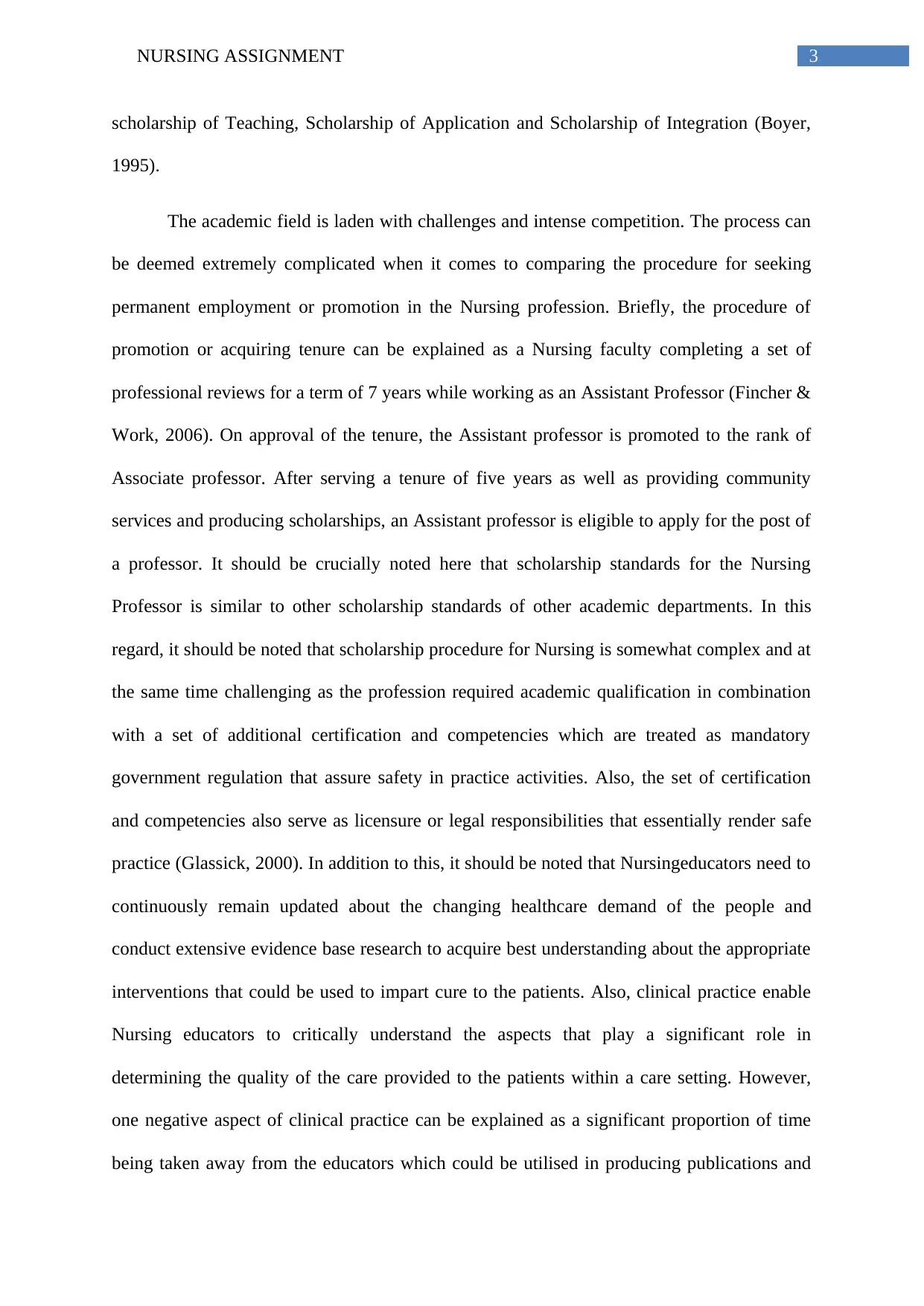
3NURSING ASSIGNMENT
scholarship of Teaching, Scholarship of Application and Scholarship of Integration (Boyer,
1995).
The academic field is laden with challenges and intense competition. The process can
be deemed extremely complicated when it comes to comparing the procedure for seeking
permanent employment or promotion in the Nursing profession. Briefly, the procedure of
promotion or acquiring tenure can be explained as a Nursing faculty completing a set of
professional reviews for a term of 7 years while working as an Assistant Professor (Fincher &
Work, 2006). On approval of the tenure, the Assistant professor is promoted to the rank of
Associate professor. After serving a tenure of five years as well as providing community
services and producing scholarships, an Assistant professor is eligible to apply for the post of
a professor. It should be crucially noted here that scholarship standards for the Nursing
Professor is similar to other scholarship standards of other academic departments. In this
regard, it should be noted that scholarship procedure for Nursing is somewhat complex and at
the same time challenging as the profession required academic qualification in combination
with a set of additional certification and competencies which are treated as mandatory
government regulation that assure safety in practice activities. Also, the set of certification
and competencies also serve as licensure or legal responsibilities that essentially render safe
practice (Glassick, 2000). In addition to this, it should be noted that Nursingeducators need to
continuously remain updated about the changing healthcare demand of the people and
conduct extensive evidence base research to acquire best understanding about the appropriate
interventions that could be used to impart cure to the patients. Also, clinical practice enable
Nursing educators to critically understand the aspects that play a significant role in
determining the quality of the care provided to the patients within a care setting. However,
one negative aspect of clinical practice can be explained as a significant proportion of time
being taken away from the educators which could be utilised in producing publications and
scholarship of Teaching, Scholarship of Application and Scholarship of Integration (Boyer,
1995).
The academic field is laden with challenges and intense competition. The process can
be deemed extremely complicated when it comes to comparing the procedure for seeking
permanent employment or promotion in the Nursing profession. Briefly, the procedure of
promotion or acquiring tenure can be explained as a Nursing faculty completing a set of
professional reviews for a term of 7 years while working as an Assistant Professor (Fincher &
Work, 2006). On approval of the tenure, the Assistant professor is promoted to the rank of
Associate professor. After serving a tenure of five years as well as providing community
services and producing scholarships, an Assistant professor is eligible to apply for the post of
a professor. It should be crucially noted here that scholarship standards for the Nursing
Professor is similar to other scholarship standards of other academic departments. In this
regard, it should be noted that scholarship procedure for Nursing is somewhat complex and at
the same time challenging as the profession required academic qualification in combination
with a set of additional certification and competencies which are treated as mandatory
government regulation that assure safety in practice activities. Also, the set of certification
and competencies also serve as licensure or legal responsibilities that essentially render safe
practice (Glassick, 2000). In addition to this, it should be noted that Nursingeducators need to
continuously remain updated about the changing healthcare demand of the people and
conduct extensive evidence base research to acquire best understanding about the appropriate
interventions that could be used to impart cure to the patients. Also, clinical practice enable
Nursing educators to critically understand the aspects that play a significant role in
determining the quality of the care provided to the patients within a care setting. However,
one negative aspect of clinical practice can be explained as a significant proportion of time
being taken away from the educators which could be utilised in producing publications and
Paraphrase This Document
Need a fresh take? Get an instant paraphrase of this document with our AI Paraphraser
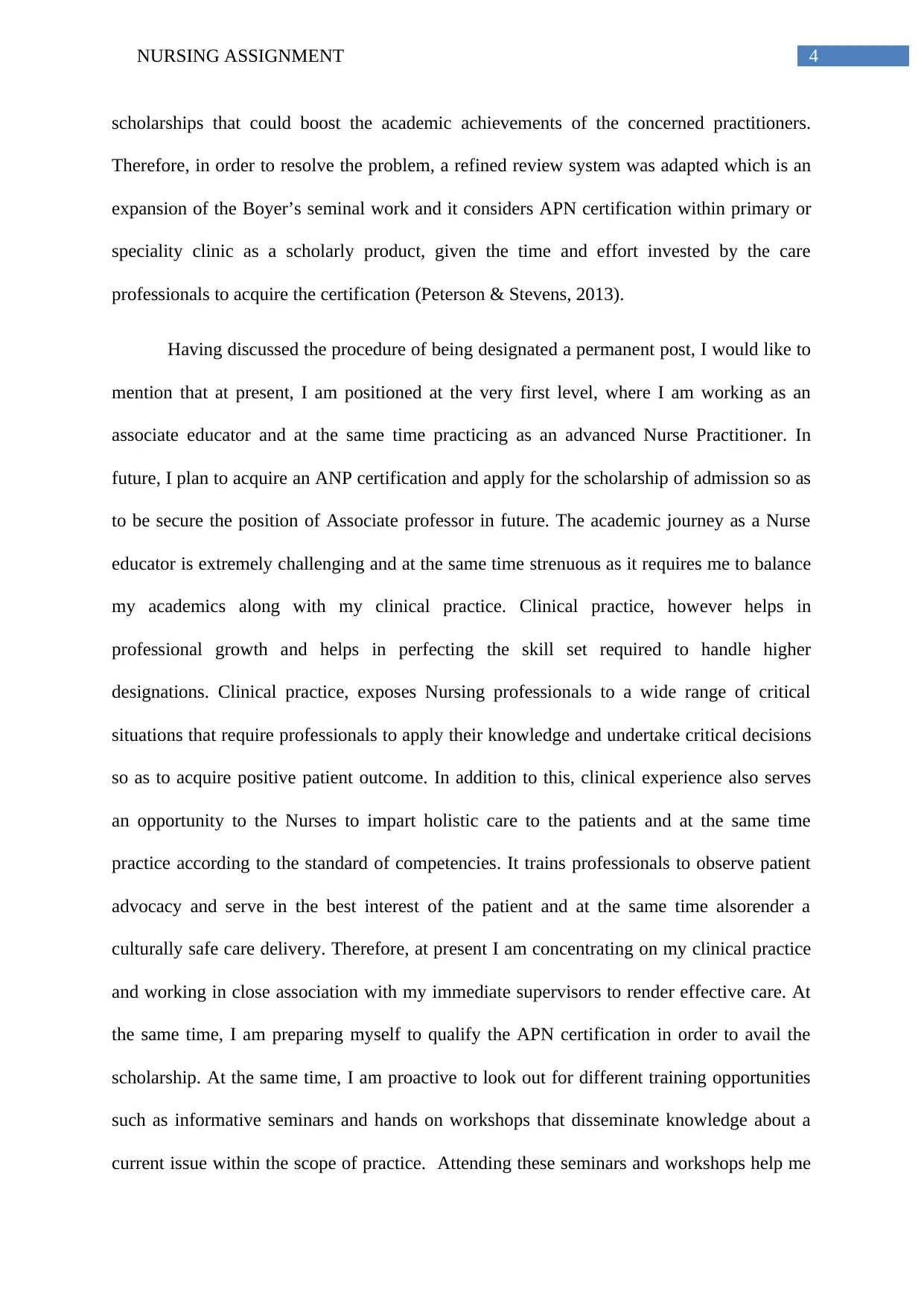
4NURSING ASSIGNMENT
scholarships that could boost the academic achievements of the concerned practitioners.
Therefore, in order to resolve the problem, a refined review system was adapted which is an
expansion of the Boyer’s seminal work and it considers APN certification within primary or
speciality clinic as a scholarly product, given the time and effort invested by the care
professionals to acquire the certification (Peterson & Stevens, 2013).
Having discussed the procedure of being designated a permanent post, I would like to
mention that at present, I am positioned at the very first level, where I am working as an
associate educator and at the same time practicing as an advanced Nurse Practitioner. In
future, I plan to acquire an ANP certification and apply for the scholarship of admission so as
to be secure the position of Associate professor in future. The academic journey as a Nurse
educator is extremely challenging and at the same time strenuous as it requires me to balance
my academics along with my clinical practice. Clinical practice, however helps in
professional growth and helps in perfecting the skill set required to handle higher
designations. Clinical practice, exposes Nursing professionals to a wide range of critical
situations that require professionals to apply their knowledge and undertake critical decisions
so as to acquire positive patient outcome. In addition to this, clinical experience also serves
an opportunity to the Nurses to impart holistic care to the patients and at the same time
practice according to the standard of competencies. It trains professionals to observe patient
advocacy and serve in the best interest of the patient and at the same time alsorender a
culturally safe care delivery. Therefore, at present I am concentrating on my clinical practice
and working in close association with my immediate supervisors to render effective care. At
the same time, I am preparing myself to qualify the APN certification in order to avail the
scholarship. At the same time, I am proactive to look out for different training opportunities
such as informative seminars and hands on workshops that disseminate knowledge about a
current issue within the scope of practice. Attending these seminars and workshops help me
scholarships that could boost the academic achievements of the concerned practitioners.
Therefore, in order to resolve the problem, a refined review system was adapted which is an
expansion of the Boyer’s seminal work and it considers APN certification within primary or
speciality clinic as a scholarly product, given the time and effort invested by the care
professionals to acquire the certification (Peterson & Stevens, 2013).
Having discussed the procedure of being designated a permanent post, I would like to
mention that at present, I am positioned at the very first level, where I am working as an
associate educator and at the same time practicing as an advanced Nurse Practitioner. In
future, I plan to acquire an ANP certification and apply for the scholarship of admission so as
to be secure the position of Associate professor in future. The academic journey as a Nurse
educator is extremely challenging and at the same time strenuous as it requires me to balance
my academics along with my clinical practice. Clinical practice, however helps in
professional growth and helps in perfecting the skill set required to handle higher
designations. Clinical practice, exposes Nursing professionals to a wide range of critical
situations that require professionals to apply their knowledge and undertake critical decisions
so as to acquire positive patient outcome. In addition to this, clinical experience also serves
an opportunity to the Nurses to impart holistic care to the patients and at the same time
practice according to the standard of competencies. It trains professionals to observe patient
advocacy and serve in the best interest of the patient and at the same time alsorender a
culturally safe care delivery. Therefore, at present I am concentrating on my clinical practice
and working in close association with my immediate supervisors to render effective care. At
the same time, I am preparing myself to qualify the APN certification in order to avail the
scholarship. At the same time, I am proactive to look out for different training opportunities
such as informative seminars and hands on workshops that disseminate knowledge about a
current issue within the scope of practice. Attending these seminars and workshops help me
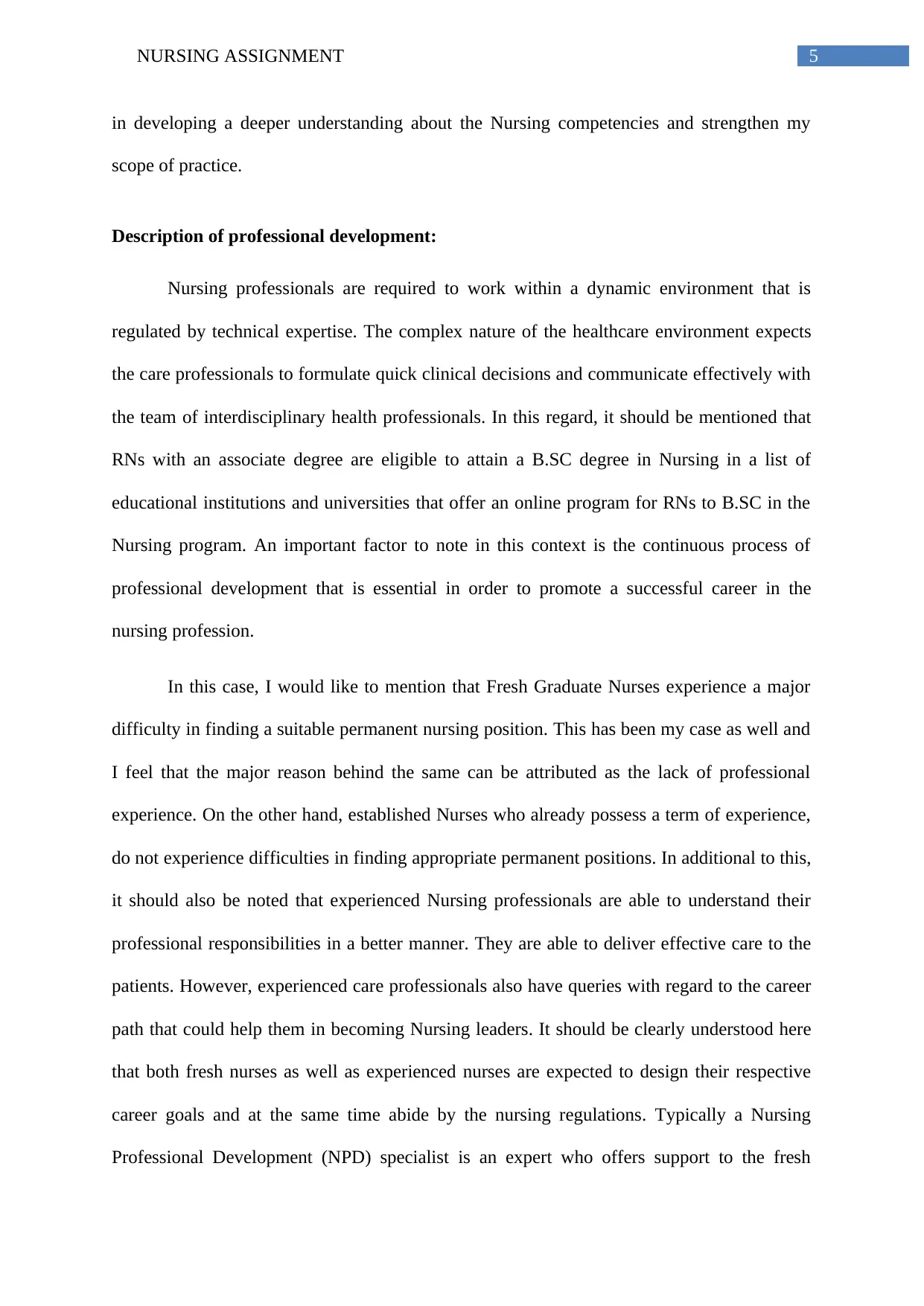
5NURSING ASSIGNMENT
in developing a deeper understanding about the Nursing competencies and strengthen my
scope of practice.
Description of professional development:
Nursing professionals are required to work within a dynamic environment that is
regulated by technical expertise. The complex nature of the healthcare environment expects
the care professionals to formulate quick clinical decisions and communicate effectively with
the team of interdisciplinary health professionals. In this regard, it should be mentioned that
RNs with an associate degree are eligible to attain a B.SC degree in Nursing in a list of
educational institutions and universities that offer an online program for RNs to B.SC in the
Nursing program. An important factor to note in this context is the continuous process of
professional development that is essential in order to promote a successful career in the
nursing profession.
In this case, I would like to mention that Fresh Graduate Nurses experience a major
difficulty in finding a suitable permanent nursing position. This has been my case as well and
I feel that the major reason behind the same can be attributed as the lack of professional
experience. On the other hand, established Nurses who already possess a term of experience,
do not experience difficulties in finding appropriate permanent positions. In additional to this,
it should also be noted that experienced Nursing professionals are able to understand their
professional responsibilities in a better manner. They are able to deliver effective care to the
patients. However, experienced care professionals also have queries with regard to the career
path that could help them in becoming Nursing leaders. It should be clearly understood here
that both fresh nurses as well as experienced nurses are expected to design their respective
career goals and at the same time abide by the nursing regulations. Typically a Nursing
Professional Development (NPD) specialist is an expert who offers support to the fresh
in developing a deeper understanding about the Nursing competencies and strengthen my
scope of practice.
Description of professional development:
Nursing professionals are required to work within a dynamic environment that is
regulated by technical expertise. The complex nature of the healthcare environment expects
the care professionals to formulate quick clinical decisions and communicate effectively with
the team of interdisciplinary health professionals. In this regard, it should be mentioned that
RNs with an associate degree are eligible to attain a B.SC degree in Nursing in a list of
educational institutions and universities that offer an online program for RNs to B.SC in the
Nursing program. An important factor to note in this context is the continuous process of
professional development that is essential in order to promote a successful career in the
nursing profession.
In this case, I would like to mention that Fresh Graduate Nurses experience a major
difficulty in finding a suitable permanent nursing position. This has been my case as well and
I feel that the major reason behind the same can be attributed as the lack of professional
experience. On the other hand, established Nurses who already possess a term of experience,
do not experience difficulties in finding appropriate permanent positions. In additional to this,
it should also be noted that experienced Nursing professionals are able to understand their
professional responsibilities in a better manner. They are able to deliver effective care to the
patients. However, experienced care professionals also have queries with regard to the career
path that could help them in becoming Nursing leaders. It should be clearly understood here
that both fresh nurses as well as experienced nurses are expected to design their respective
career goals and at the same time abide by the nursing regulations. Typically a Nursing
Professional Development (NPD) specialist is an expert who offers support to the fresh
⊘ This is a preview!⊘
Do you want full access?
Subscribe today to unlock all pages.

Trusted by 1+ million students worldwide
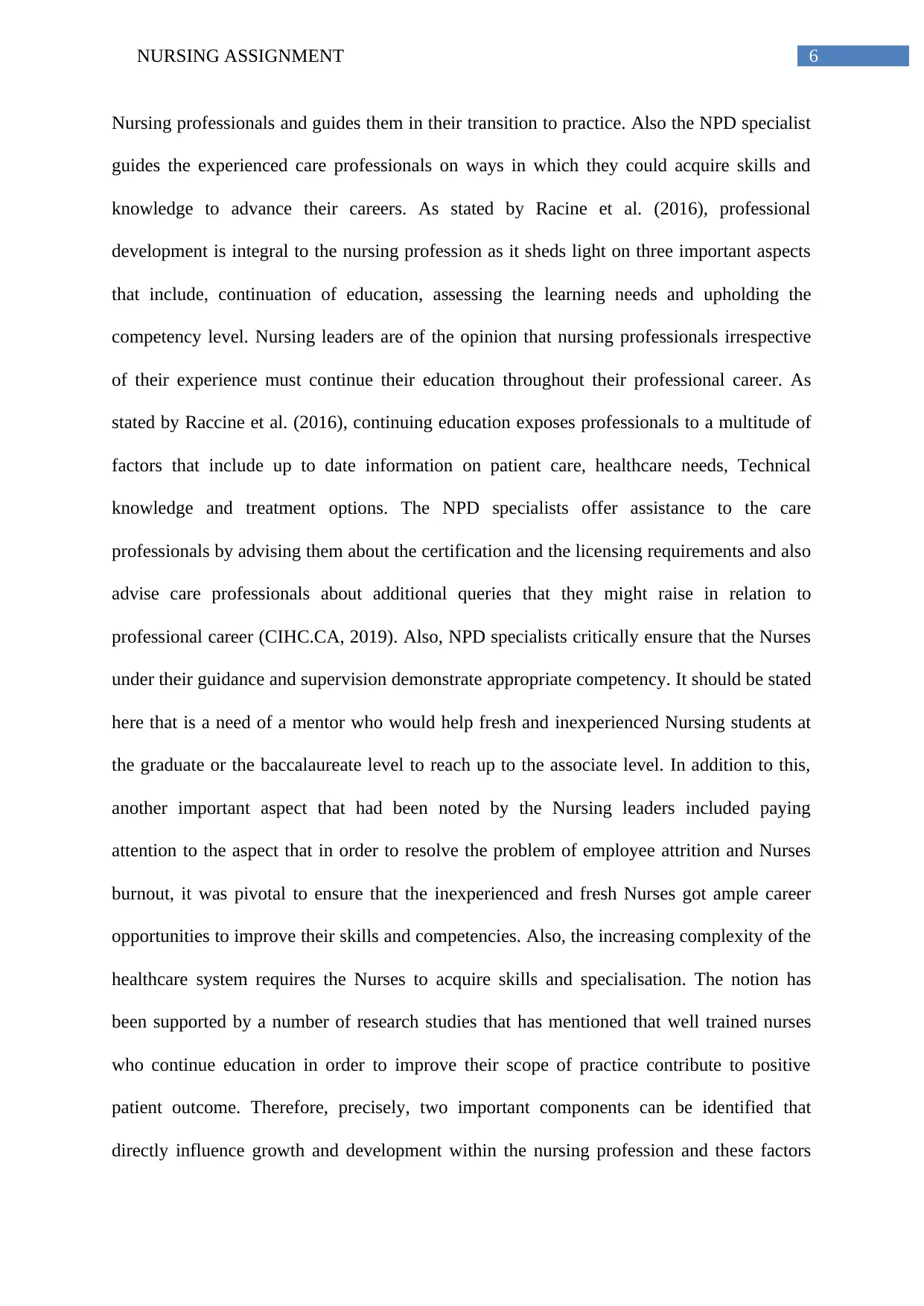
6NURSING ASSIGNMENT
Nursing professionals and guides them in their transition to practice. Also the NPD specialist
guides the experienced care professionals on ways in which they could acquire skills and
knowledge to advance their careers. As stated by Racine et al. (2016), professional
development is integral to the nursing profession as it sheds light on three important aspects
that include, continuation of education, assessing the learning needs and upholding the
competency level. Nursing leaders are of the opinion that nursing professionals irrespective
of their experience must continue their education throughout their professional career. As
stated by Raccine et al. (2016), continuing education exposes professionals to a multitude of
factors that include up to date information on patient care, healthcare needs, Technical
knowledge and treatment options. The NPD specialists offer assistance to the care
professionals by advising them about the certification and the licensing requirements and also
advise care professionals about additional queries that they might raise in relation to
professional career (CIHC.CA, 2019). Also, NPD specialists critically ensure that the Nurses
under their guidance and supervision demonstrate appropriate competency. It should be stated
here that is a need of a mentor who would help fresh and inexperienced Nursing students at
the graduate or the baccalaureate level to reach up to the associate level. In addition to this,
another important aspect that had been noted by the Nursing leaders included paying
attention to the aspect that in order to resolve the problem of employee attrition and Nurses
burnout, it was pivotal to ensure that the inexperienced and fresh Nurses got ample career
opportunities to improve their skills and competencies. Also, the increasing complexity of the
healthcare system requires the Nurses to acquire skills and specialisation. The notion has
been supported by a number of research studies that has mentioned that well trained nurses
who continue education in order to improve their scope of practice contribute to positive
patient outcome. Therefore, precisely, two important components can be identified that
directly influence growth and development within the nursing profession and these factors
Nursing professionals and guides them in their transition to practice. Also the NPD specialist
guides the experienced care professionals on ways in which they could acquire skills and
knowledge to advance their careers. As stated by Racine et al. (2016), professional
development is integral to the nursing profession as it sheds light on three important aspects
that include, continuation of education, assessing the learning needs and upholding the
competency level. Nursing leaders are of the opinion that nursing professionals irrespective
of their experience must continue their education throughout their professional career. As
stated by Raccine et al. (2016), continuing education exposes professionals to a multitude of
factors that include up to date information on patient care, healthcare needs, Technical
knowledge and treatment options. The NPD specialists offer assistance to the care
professionals by advising them about the certification and the licensing requirements and also
advise care professionals about additional queries that they might raise in relation to
professional career (CIHC.CA, 2019). Also, NPD specialists critically ensure that the Nurses
under their guidance and supervision demonstrate appropriate competency. It should be stated
here that is a need of a mentor who would help fresh and inexperienced Nursing students at
the graduate or the baccalaureate level to reach up to the associate level. In addition to this,
another important aspect that had been noted by the Nursing leaders included paying
attention to the aspect that in order to resolve the problem of employee attrition and Nurses
burnout, it was pivotal to ensure that the inexperienced and fresh Nurses got ample career
opportunities to improve their skills and competencies. Also, the increasing complexity of the
healthcare system requires the Nurses to acquire skills and specialisation. The notion has
been supported by a number of research studies that has mentioned that well trained nurses
who continue education in order to improve their scope of practice contribute to positive
patient outcome. Therefore, precisely, two important components can be identified that
directly influence growth and development within the nursing profession and these factors
Paraphrase This Document
Need a fresh take? Get an instant paraphrase of this document with our AI Paraphraser
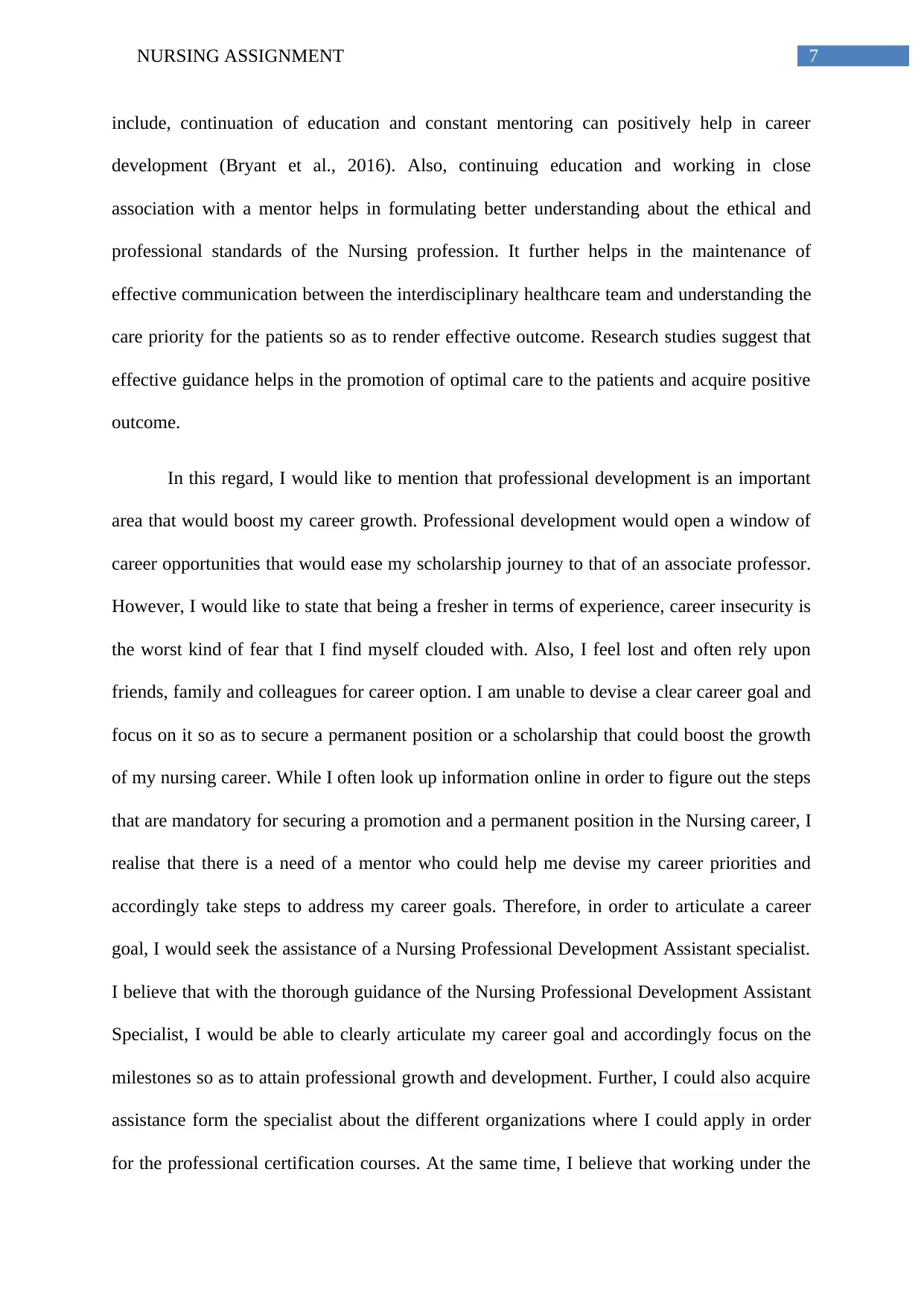
7NURSING ASSIGNMENT
include, continuation of education and constant mentoring can positively help in career
development (Bryant et al., 2016). Also, continuing education and working in close
association with a mentor helps in formulating better understanding about the ethical and
professional standards of the Nursing profession. It further helps in the maintenance of
effective communication between the interdisciplinary healthcare team and understanding the
care priority for the patients so as to render effective outcome. Research studies suggest that
effective guidance helps in the promotion of optimal care to the patients and acquire positive
outcome.
In this regard, I would like to mention that professional development is an important
area that would boost my career growth. Professional development would open a window of
career opportunities that would ease my scholarship journey to that of an associate professor.
However, I would like to state that being a fresher in terms of experience, career insecurity is
the worst kind of fear that I find myself clouded with. Also, I feel lost and often rely upon
friends, family and colleagues for career option. I am unable to devise a clear career goal and
focus on it so as to secure a permanent position or a scholarship that could boost the growth
of my nursing career. While I often look up information online in order to figure out the steps
that are mandatory for securing a promotion and a permanent position in the Nursing career, I
realise that there is a need of a mentor who could help me devise my career priorities and
accordingly take steps to address my career goals. Therefore, in order to articulate a career
goal, I would seek the assistance of a Nursing Professional Development Assistant specialist.
I believe that with the thorough guidance of the Nursing Professional Development Assistant
Specialist, I would be able to clearly articulate my career goal and accordingly focus on the
milestones so as to attain professional growth and development. Further, I could also acquire
assistance form the specialist about the different organizations where I could apply in order
for the professional certification courses. At the same time, I believe that working under the
include, continuation of education and constant mentoring can positively help in career
development (Bryant et al., 2016). Also, continuing education and working in close
association with a mentor helps in formulating better understanding about the ethical and
professional standards of the Nursing profession. It further helps in the maintenance of
effective communication between the interdisciplinary healthcare team and understanding the
care priority for the patients so as to render effective outcome. Research studies suggest that
effective guidance helps in the promotion of optimal care to the patients and acquire positive
outcome.
In this regard, I would like to mention that professional development is an important
area that would boost my career growth. Professional development would open a window of
career opportunities that would ease my scholarship journey to that of an associate professor.
However, I would like to state that being a fresher in terms of experience, career insecurity is
the worst kind of fear that I find myself clouded with. Also, I feel lost and often rely upon
friends, family and colleagues for career option. I am unable to devise a clear career goal and
focus on it so as to secure a permanent position or a scholarship that could boost the growth
of my nursing career. While I often look up information online in order to figure out the steps
that are mandatory for securing a promotion and a permanent position in the Nursing career, I
realise that there is a need of a mentor who could help me devise my career priorities and
accordingly take steps to address my career goals. Therefore, in order to articulate a career
goal, I would seek the assistance of a Nursing Professional Development Assistant specialist.
I believe that with the thorough guidance of the Nursing Professional Development Assistant
Specialist, I would be able to clearly articulate my career goal and accordingly focus on the
milestones so as to attain professional growth and development. Further, I could also acquire
assistance form the specialist about the different organizations where I could apply in order
for the professional certification courses. At the same time, I believe that working under the
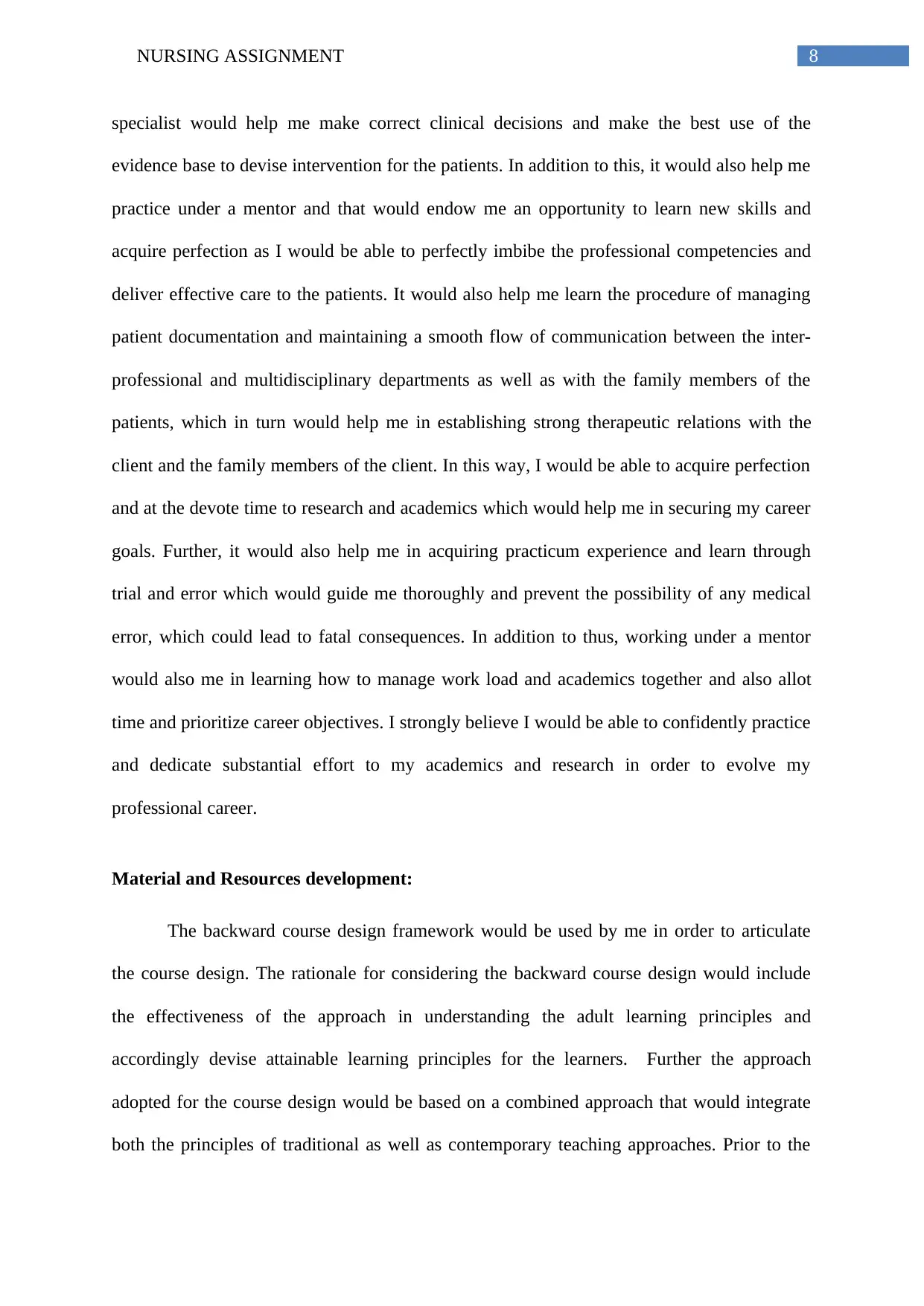
8NURSING ASSIGNMENT
specialist would help me make correct clinical decisions and make the best use of the
evidence base to devise intervention for the patients. In addition to this, it would also help me
practice under a mentor and that would endow me an opportunity to learn new skills and
acquire perfection as I would be able to perfectly imbibe the professional competencies and
deliver effective care to the patients. It would also help me learn the procedure of managing
patient documentation and maintaining a smooth flow of communication between the inter-
professional and multidisciplinary departments as well as with the family members of the
patients, which in turn would help me in establishing strong therapeutic relations with the
client and the family members of the client. In this way, I would be able to acquire perfection
and at the devote time to research and academics which would help me in securing my career
goals. Further, it would also help me in acquiring practicum experience and learn through
trial and error which would guide me thoroughly and prevent the possibility of any medical
error, which could lead to fatal consequences. In addition to thus, working under a mentor
would also me in learning how to manage work load and academics together and also allot
time and prioritize career objectives. I strongly believe I would be able to confidently practice
and dedicate substantial effort to my academics and research in order to evolve my
professional career.
Material and Resources development:
The backward course design framework would be used by me in order to articulate
the course design. The rationale for considering the backward course design would include
the effectiveness of the approach in understanding the adult learning principles and
accordingly devise attainable learning principles for the learners. Further the approach
adopted for the course design would be based on a combined approach that would integrate
both the principles of traditional as well as contemporary teaching approaches. Prior to the
specialist would help me make correct clinical decisions and make the best use of the
evidence base to devise intervention for the patients. In addition to this, it would also help me
practice under a mentor and that would endow me an opportunity to learn new skills and
acquire perfection as I would be able to perfectly imbibe the professional competencies and
deliver effective care to the patients. It would also help me learn the procedure of managing
patient documentation and maintaining a smooth flow of communication between the inter-
professional and multidisciplinary departments as well as with the family members of the
patients, which in turn would help me in establishing strong therapeutic relations with the
client and the family members of the client. In this way, I would be able to acquire perfection
and at the devote time to research and academics which would help me in securing my career
goals. Further, it would also help me in acquiring practicum experience and learn through
trial and error which would guide me thoroughly and prevent the possibility of any medical
error, which could lead to fatal consequences. In addition to thus, working under a mentor
would also me in learning how to manage work load and academics together and also allot
time and prioritize career objectives. I strongly believe I would be able to confidently practice
and dedicate substantial effort to my academics and research in order to evolve my
professional career.
Material and Resources development:
The backward course design framework would be used by me in order to articulate
the course design. The rationale for considering the backward course design would include
the effectiveness of the approach in understanding the adult learning principles and
accordingly devise attainable learning principles for the learners. Further the approach
adopted for the course design would be based on a combined approach that would integrate
both the principles of traditional as well as contemporary teaching approaches. Prior to the
⊘ This is a preview!⊘
Do you want full access?
Subscribe today to unlock all pages.

Trusted by 1+ million students worldwide
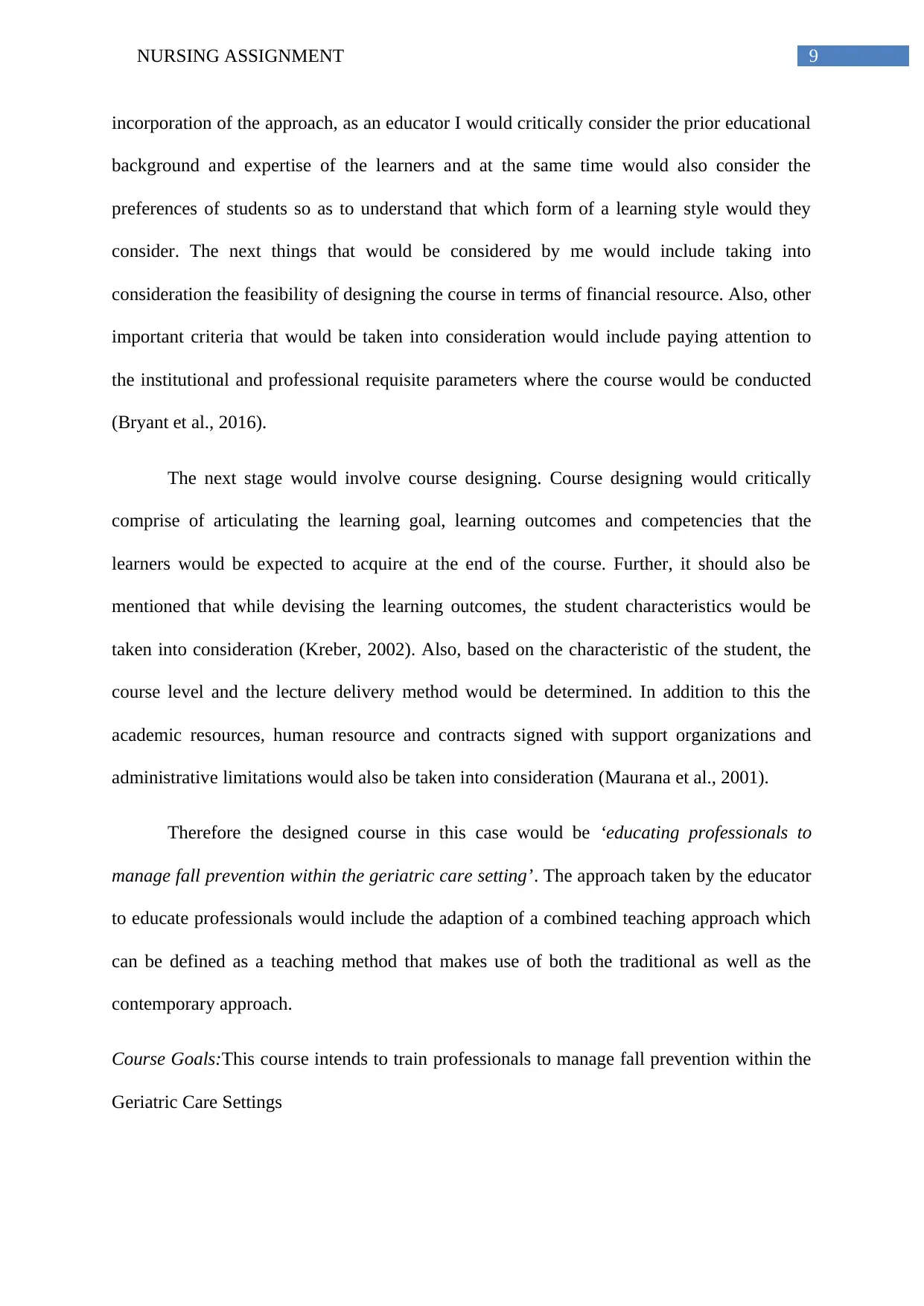
9NURSING ASSIGNMENT
incorporation of the approach, as an educator I would critically consider the prior educational
background and expertise of the learners and at the same time would also consider the
preferences of students so as to understand that which form of a learning style would they
consider. The next things that would be considered by me would include taking into
consideration the feasibility of designing the course in terms of financial resource. Also, other
important criteria that would be taken into consideration would include paying attention to
the institutional and professional requisite parameters where the course would be conducted
(Bryant et al., 2016).
The next stage would involve course designing. Course designing would critically
comprise of articulating the learning goal, learning outcomes and competencies that the
learners would be expected to acquire at the end of the course. Further, it should also be
mentioned that while devising the learning outcomes, the student characteristics would be
taken into consideration (Kreber, 2002). Also, based on the characteristic of the student, the
course level and the lecture delivery method would be determined. In addition to this the
academic resources, human resource and contracts signed with support organizations and
administrative limitations would also be taken into consideration (Maurana et al., 2001).
Therefore the designed course in this case would be ‘educating professionals to
manage fall prevention within the geriatric care setting’. The approach taken by the educator
to educate professionals would include the adaption of a combined teaching approach which
can be defined as a teaching method that makes use of both the traditional as well as the
contemporary approach.
Course Goals:This course intends to train professionals to manage fall prevention within the
Geriatric Care Settings
incorporation of the approach, as an educator I would critically consider the prior educational
background and expertise of the learners and at the same time would also consider the
preferences of students so as to understand that which form of a learning style would they
consider. The next things that would be considered by me would include taking into
consideration the feasibility of designing the course in terms of financial resource. Also, other
important criteria that would be taken into consideration would include paying attention to
the institutional and professional requisite parameters where the course would be conducted
(Bryant et al., 2016).
The next stage would involve course designing. Course designing would critically
comprise of articulating the learning goal, learning outcomes and competencies that the
learners would be expected to acquire at the end of the course. Further, it should also be
mentioned that while devising the learning outcomes, the student characteristics would be
taken into consideration (Kreber, 2002). Also, based on the characteristic of the student, the
course level and the lecture delivery method would be determined. In addition to this the
academic resources, human resource and contracts signed with support organizations and
administrative limitations would also be taken into consideration (Maurana et al., 2001).
Therefore the designed course in this case would be ‘educating professionals to
manage fall prevention within the geriatric care setting’. The approach taken by the educator
to educate professionals would include the adaption of a combined teaching approach which
can be defined as a teaching method that makes use of both the traditional as well as the
contemporary approach.
Course Goals:This course intends to train professionals to manage fall prevention within the
Geriatric Care Settings
Paraphrase This Document
Need a fresh take? Get an instant paraphrase of this document with our AI Paraphraser
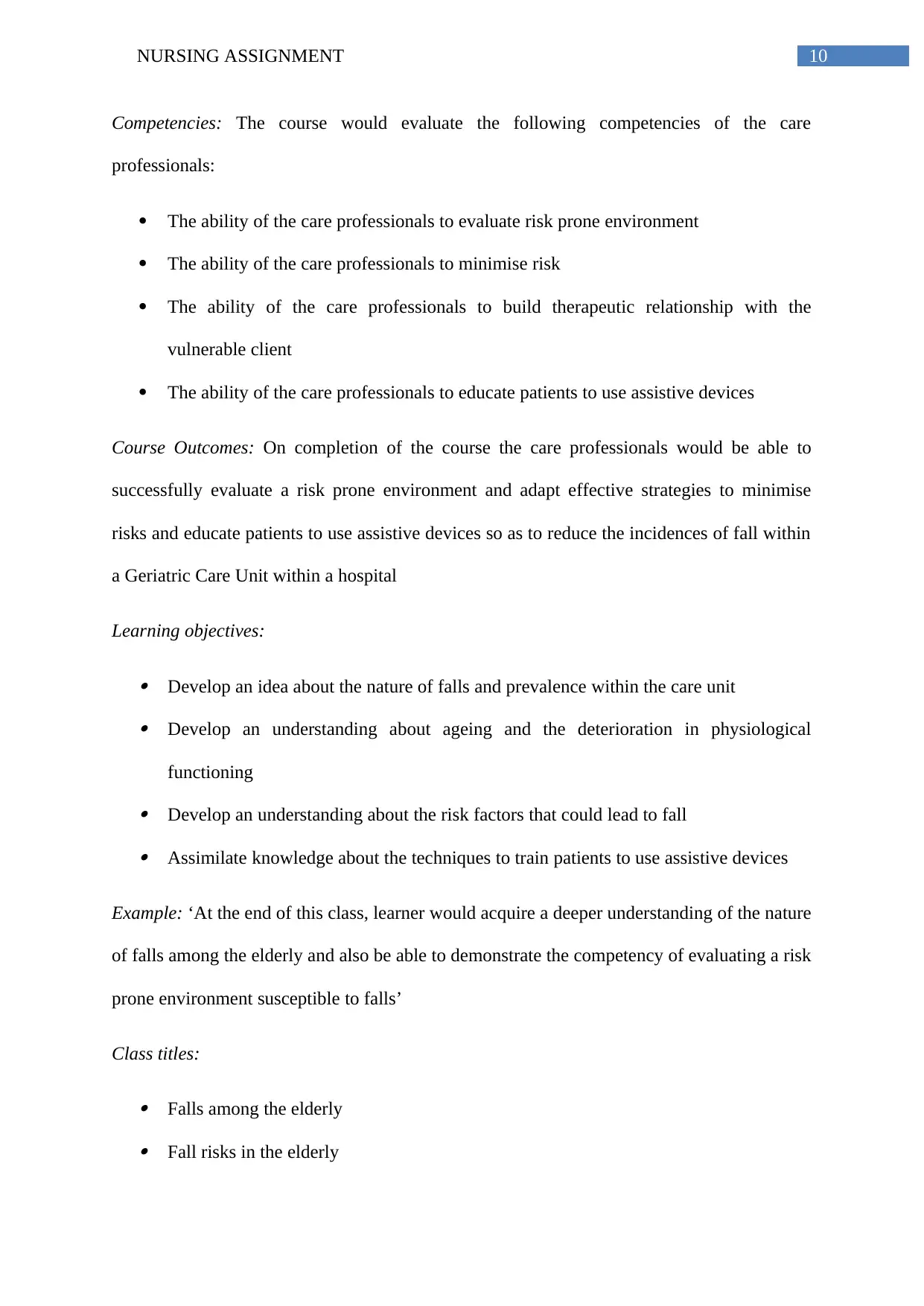
10NURSING ASSIGNMENT
Competencies: The course would evaluate the following competencies of the care
professionals:
The ability of the care professionals to evaluate risk prone environment
The ability of the care professionals to minimise risk
The ability of the care professionals to build therapeutic relationship with the
vulnerable client
The ability of the care professionals to educate patients to use assistive devices
Course Outcomes: On completion of the course the care professionals would be able to
successfully evaluate a risk prone environment and adapt effective strategies to minimise
risks and educate patients to use assistive devices so as to reduce the incidences of fall within
a Geriatric Care Unit within a hospital
Learning objectives:
Develop an idea about the nature of falls and prevalence within the care unit Develop an understanding about ageing and the deterioration in physiological
functioning Develop an understanding about the risk factors that could lead to fall Assimilate knowledge about the techniques to train patients to use assistive devices
Example: ‘At the end of this class, learner would acquire a deeper understanding of the nature
of falls among the elderly and also be able to demonstrate the competency of evaluating a risk
prone environment susceptible to falls’
Class titles:
Falls among the elderly Fall risks in the elderly
Competencies: The course would evaluate the following competencies of the care
professionals:
The ability of the care professionals to evaluate risk prone environment
The ability of the care professionals to minimise risk
The ability of the care professionals to build therapeutic relationship with the
vulnerable client
The ability of the care professionals to educate patients to use assistive devices
Course Outcomes: On completion of the course the care professionals would be able to
successfully evaluate a risk prone environment and adapt effective strategies to minimise
risks and educate patients to use assistive devices so as to reduce the incidences of fall within
a Geriatric Care Unit within a hospital
Learning objectives:
Develop an idea about the nature of falls and prevalence within the care unit Develop an understanding about ageing and the deterioration in physiological
functioning Develop an understanding about the risk factors that could lead to fall Assimilate knowledge about the techniques to train patients to use assistive devices
Example: ‘At the end of this class, learner would acquire a deeper understanding of the nature
of falls among the elderly and also be able to demonstrate the competency of evaluating a risk
prone environment susceptible to falls’
Class titles:
Falls among the elderly Fall risks in the elderly
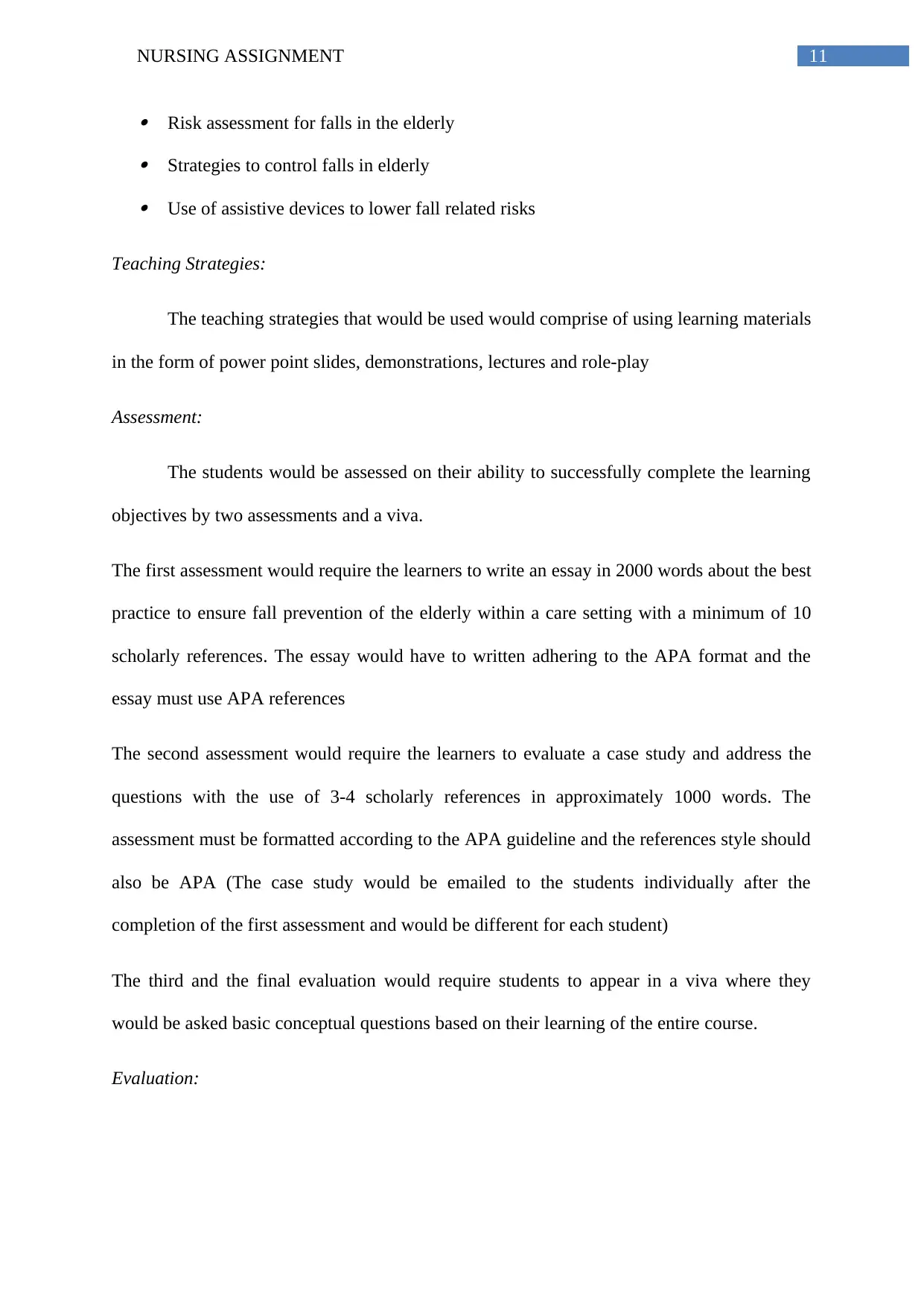
11NURSING ASSIGNMENT
Risk assessment for falls in the elderly Strategies to control falls in elderly Use of assistive devices to lower fall related risks
Teaching Strategies:
The teaching strategies that would be used would comprise of using learning materials
in the form of power point slides, demonstrations, lectures and role-play
Assessment:
The students would be assessed on their ability to successfully complete the learning
objectives by two assessments and a viva.
The first assessment would require the learners to write an essay in 2000 words about the best
practice to ensure fall prevention of the elderly within a care setting with a minimum of 10
scholarly references. The essay would have to written adhering to the APA format and the
essay must use APA references
The second assessment would require the learners to evaluate a case study and address the
questions with the use of 3-4 scholarly references in approximately 1000 words. The
assessment must be formatted according to the APA guideline and the references style should
also be APA (The case study would be emailed to the students individually after the
completion of the first assessment and would be different for each student)
The third and the final evaluation would require students to appear in a viva where they
would be asked basic conceptual questions based on their learning of the entire course.
Evaluation:
Risk assessment for falls in the elderly Strategies to control falls in elderly Use of assistive devices to lower fall related risks
Teaching Strategies:
The teaching strategies that would be used would comprise of using learning materials
in the form of power point slides, demonstrations, lectures and role-play
Assessment:
The students would be assessed on their ability to successfully complete the learning
objectives by two assessments and a viva.
The first assessment would require the learners to write an essay in 2000 words about the best
practice to ensure fall prevention of the elderly within a care setting with a minimum of 10
scholarly references. The essay would have to written adhering to the APA format and the
essay must use APA references
The second assessment would require the learners to evaluate a case study and address the
questions with the use of 3-4 scholarly references in approximately 1000 words. The
assessment must be formatted according to the APA guideline and the references style should
also be APA (The case study would be emailed to the students individually after the
completion of the first assessment and would be different for each student)
The third and the final evaluation would require students to appear in a viva where they
would be asked basic conceptual questions based on their learning of the entire course.
Evaluation:
⊘ This is a preview!⊘
Do you want full access?
Subscribe today to unlock all pages.

Trusted by 1+ million students worldwide
1 out of 17
Related Documents
Your All-in-One AI-Powered Toolkit for Academic Success.
+13062052269
info@desklib.com
Available 24*7 on WhatsApp / Email
![[object Object]](/_next/static/media/star-bottom.7253800d.svg)
Unlock your academic potential
Copyright © 2020–2025 A2Z Services. All Rights Reserved. Developed and managed by ZUCOL.





